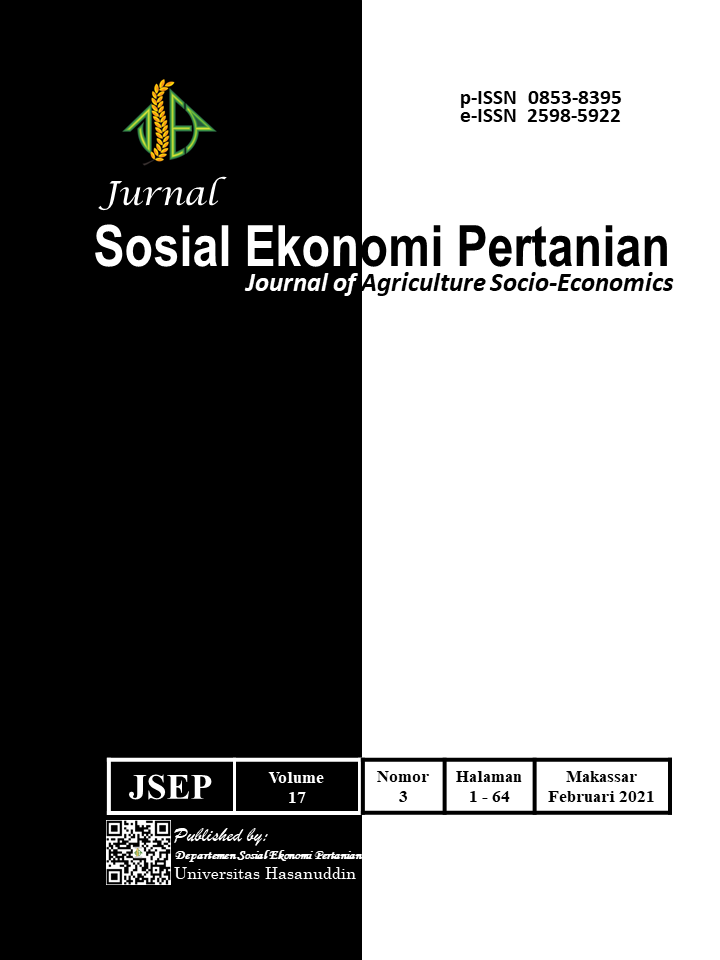Efisiensi Kinerja Rantai Pasok Beras Organik “Beras Raos”
Isi Artikel Utama
Abstrak
Dewasa ini masyarakat mulai sadar akan pentingnya pangan yang sehat, seperti beras organik. Hanya saja secara ekonomi sektor pertanian beras masih menghadapi berbagai persoalan, salah satunya harga jual di tingkat petani yang masih tergolong rendah, hal tersebut dikarenakan rantai pasok yang masih panjang juga sistem rantai pasok yang kurang optimal. Tujuan dari penelitian ini adalah menganalisis efisiensi kinerja rantai pasok beras organik “Beras Raos”. Metode penelitian yang digunakan adalah metode survei, dengan responden petani, kelompok tani Sari Alam, dan retailer yang ditentukan menggunakan purposive sampling dan snowball sampling. Analisis data menggunakan analisis deskriptif dengan pendekatan kuantitatif, dan aspek-aspek analisis efisiensi pemasaran (margin pemasaran dan farmer’s share) dan efisiensi pengelolaan asset (inventory turnover, inventory days of supply, dan cash to cash cycle time). Hasil analisis efisiensi kinerja rantai pasok tersebut menunjukkan belum efisien sepenuhnya, seperti dalam hal: nilai farmer’s share yang masih < 70%, yakni hanya mencapai 41,8% dan nilai cash to cash cycle time yang mencapai 37 hari untuk mengubah persediaan beras organik menjadi uang, dimana rentang waktu 37 hari tersebut masih tergolong cukup lama.
Rincian Artikel

Artikel ini berlisensi Creative Commons Attribution-NonCommercial 4.0 International License.
This works is under Creative Commons Attribution LicenseReferensi
Anwar, S. N. (2013). Manajemen Rantai Pasokan (Supply Chain Management) : Konsep Dan Hakikat. Jurnal Dinamika Informatika, Vol 3 No 2 (2011).
Gitosudarmo, I. (1994). Manajemen Pemasaran. BPFE.
Gusti, P. (2012). Tataniaga Pertanian, Saluran Tataniaga, Marjin Tataniaga, dan Pemasaran.
Indriani, R., Darman, R., & Mahyuddin. (2019). Rantai Pasok Aplikasi pada Komoditas Cabe Rawit di Provinsi Gorontalo. Ideas Publishing.
Istiyanti, E. (2010). Efisiensi Pemasaran Cabai Keriting Di Kecamatan Ngemplak Kabupaten Sleman. Jurnal Pertanian MAPETA, 12, no. 2, 72–144.
Kohls, R., & Uhl, J. (2002). Marketing of Agricultural Products. Mc Millan Publishing Company.
Maghfiroh, & Marimin, N. (2013). Aplikasi Teknik Pengambilan Keputusan dalam Manajemen Rantai Pasok. IPB Press.
Manoppo, A. R., Dumais, J. N. K., & Pangemanan, P. A. (2016). Perbandingan Margin Pemasaran Beras Berdasarkan Musim Panen di Kecamatan Kakas Barat. 12, No 3.
Pujawan, I. (2005). Supply Chain Management. Guna Widya.
Rahim, A., & Hastuti, D. R. D. (2007). Pengantar, Teori dan Kasus Ekonomika Pertanian. Penebar Swadaya.
Russell, & Taylor. (2002). Operation Management : Quality and Competitiveness in a Global Environment (5th ed.). Prentice Hall International Inc.
Sari, PN. (2012). Analisis Network Supply Chain dan Pengendalian Persediaan Beras Organik. Institut Pertanian Bogor.
Sari, Prisca, & Nurmalina, R. (2013). Manajemen Rantai Pasok Pada Rantai Pasok Berjaring Beras Organik. Forum Agribisnis : Agribusiness Forum, 3(2), 111–128. https://doi.org/10.29244/fagb.3.2.111-128
Sudiyono. (2002). Pemasaran Pertanian. UMM Pers.

